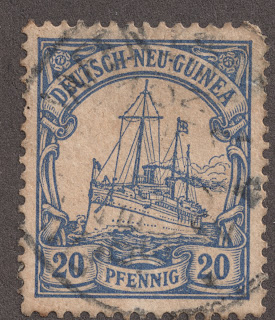1919 Scott 20 3pf brown "Kaiser's Yacht" wmk "Lonzenges"
This stamp was never placed in use because of WWI
Quick HistoryGerman New Guinea (Deutsch Neu-Guinea) was a German colonial protectorate from 1894-1914. German New Guinea consisted mainly of the area called Kaiser-Wilhelmsland in north-east New Guinea, and the nearby Bismarck Archipelago. The Capital was Herbertshohe (Kokopo), and the population was 600,000 in 1913.
In 1884, Chancellor Bismarck and the German Empire decided to embark on a colonial policy, but annexations would occur through grants of charters to private companies. On November 3, 1884, under the New Guinea Company, the German Flag was raised over the territory. German New Guinea eventually also served as the administrative center for the Caroline and Mariana islands ( bought from Spain 1899), and the Marshall Islands (1906).
After the outbreak of WWI, part of the territory of German New Guinea ( Neu-Pommern Island ) was occupied by Australian troops in 1914, and called "New Britain". Overprinted ( G.R.I.) German New Guinea stamps were used. (Stamps of New Britain are rather expensive ( minimum $25), so will say no more about them here.) The Capital of New Britain was Rabaul.
Also, during WWI, "North West Pacific Islands" stamps were produced by overprinting Australian stamps ( N.W. Pacific Islands) for German New Guinea territories occupied by Australian troops. Again, I will say no more about this, as we are discussing German New Guinea.
After the Treaty of Versailles in 1919, German New Guinea (and all of the German colonies) ceased to exist. It then became the Territory of New Guinea under Australian administration until 1949. (The Japanese occupied the territory during WWII.)
After 1949, the Territory of New Guinea was combined with the Australian territory of Papua to form the Territory of Papua and New Guinea. Finally, in 1975, Papua New Guinea gained independence from Australia, but remained a commonwealth country.
German New Guinea 1884-1919
Into the Deep Blue
The 2011 Scott Classic Specialized catalogue has, from 1897-1919, 23 major numbers for stamps of German New Guinea. Sixteen are $6+ or less ( eleven are <$2+). A representative collection should not cost much.
The 1897-99 issue, six German stamps overprinted "Deutsch-/Neu-Guinea", range in CV from $4 to $30+. Four are less than $10 CV. Of interest, Big Blue provides four spaces, just scraping the underside of the CV $10 mark. The postmark on the 5 Pfenning above is from Friedrich-Wilhelmshafen.
1901 Scott 9 10pf carmine "Hohenzollern"
"Simsonhafen" postmark; existed 1906-1910
After 1910- known as Rabaul
The 1901 issue, with the well known "Hohenzollern" design, consists of thirteen stamps, ten of which are CV $4 or less. Big Blue provides a nice 10 spaces for these stamps."Simsonhafen" postmark; existed 1906-1910
After 1910- known as Rabaul
Finally, the 1914-19 "Hohenzollern" issue, four stamps, have the Lozenges watermark. The Scott 20 3pf brown ( illustrated at the blog header) is similar to the 1901 Scott 7 variety. But the rest, Scott 21-23, have "NEUGUINEA" rather than "NEU-GUINEA" as a label.
These stamps, no doubt because of WWI and the Australian occupation, were never placed in use. Naturally, they are only catalogued mint in Scott. Three stamps are $1+ or less.
Big Blue does not really provide a space for the 1914-19 issues unless one wants to admit them into the spaces intended for the 1900 (actually 1901) issue.
Deep Blue
The Steiner has one page for the issues of German New Guinea, and naturally provides a space for all.
Big Blue
Big Blue,'69, on two lines of one page, provides four spaces for the 1897 issue, and ten spaces for the 1900 (actually 1901) issue. Coverage is 61%. A nice representative selection, marred only by no room for the 1914-19 issue. (One could stuff them into the spaces reserved for the "1900" issue, but that is a stretch.)
There are no "expensive" stamps, although the 1897 issue has three stamps in the $8-$9+ range.
BTW, the German New Guinea section is found just before French New Guinea in the '47/'41 editions.
Simple Checklist
1897
1,2,3,4,
1900 (actually 1901)
7,8,9,10,
11,12,13,14,15,16,
Comments
A) Expensive stamps ($10 threshold) : None
B) No (realistic) room for the 1914-19 issue
Map of Papua New Guinea today
Out of the Blue
Many of the stamps are easier found in mint condition, as evidenced by the perusal of feeder albums and the Scott prices. And the 1914-19 issue stamps can only be found in mint, as they were never placed in use.
Would like to hear from you-leave a comment!

















.gif)

















.jpg)
















